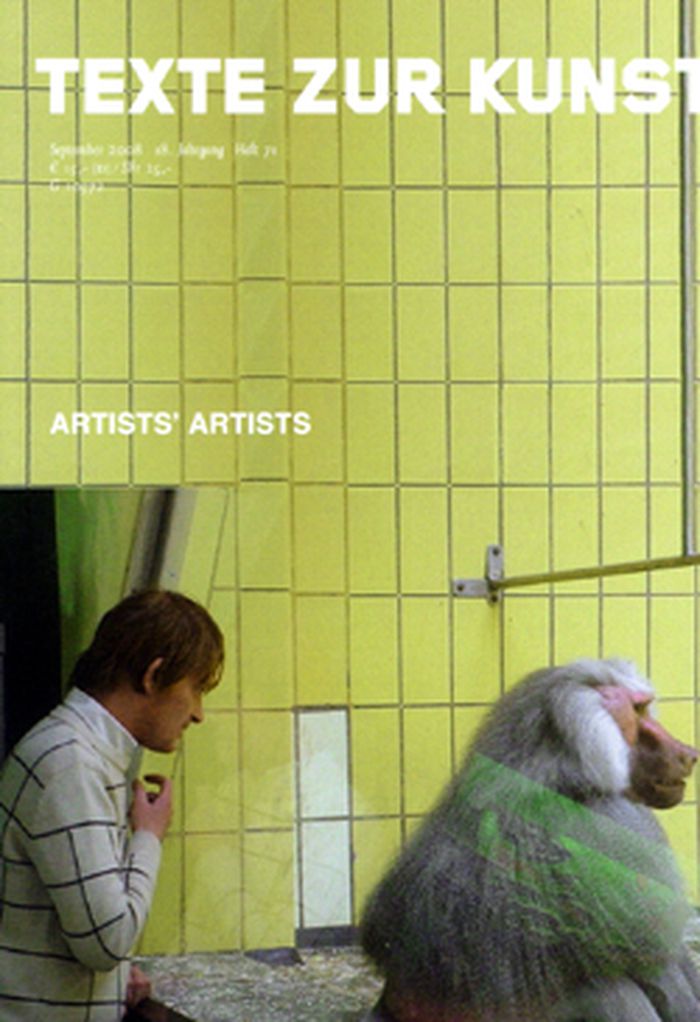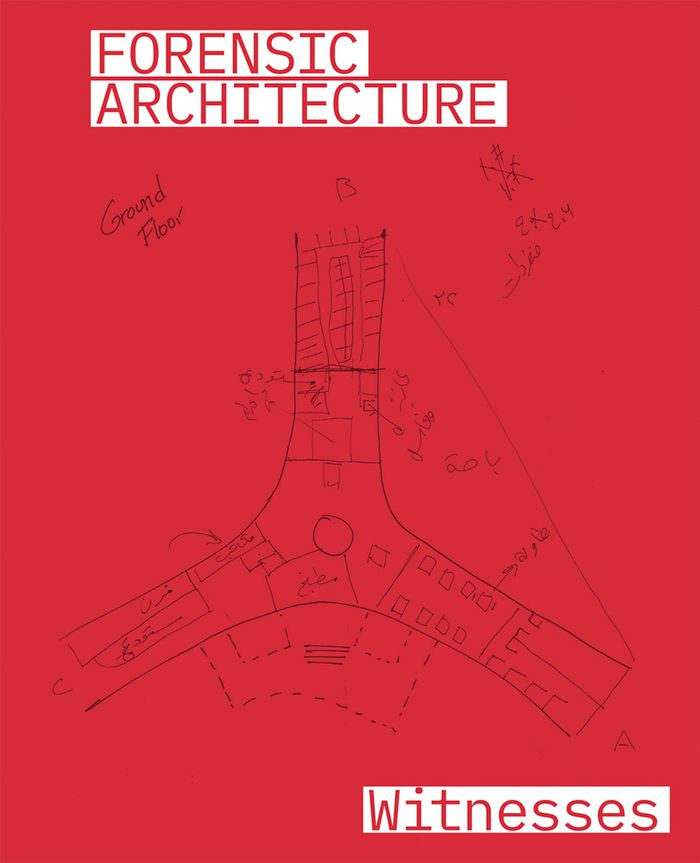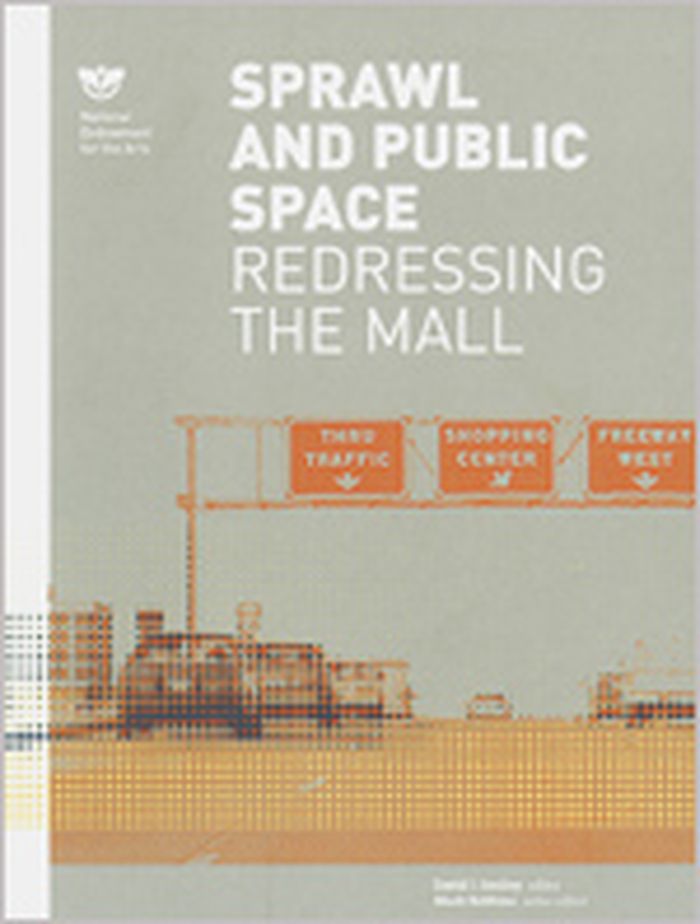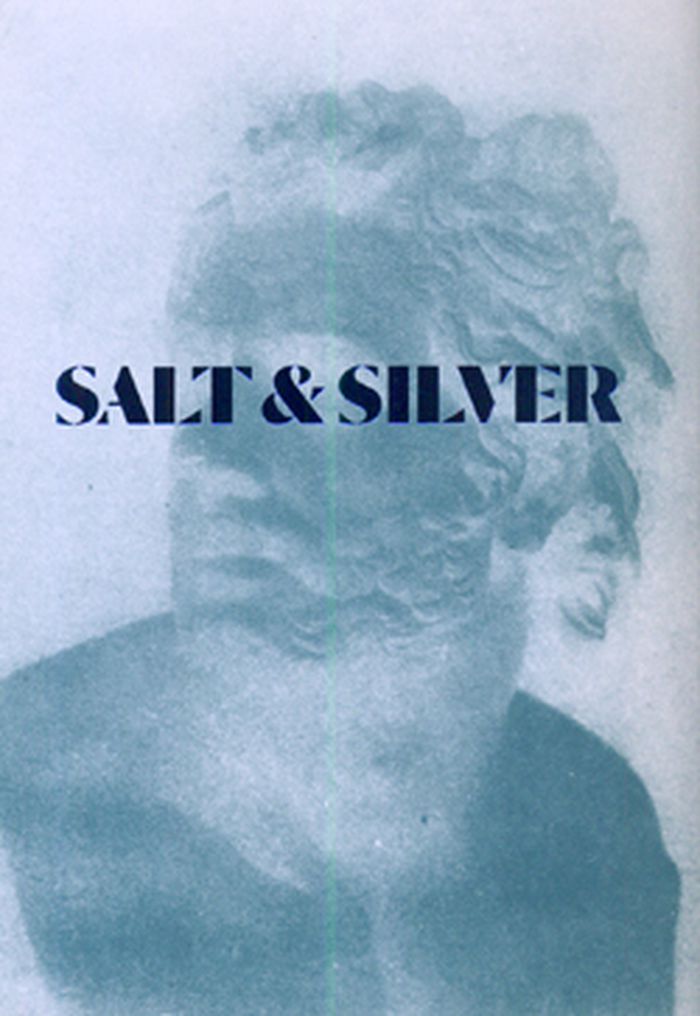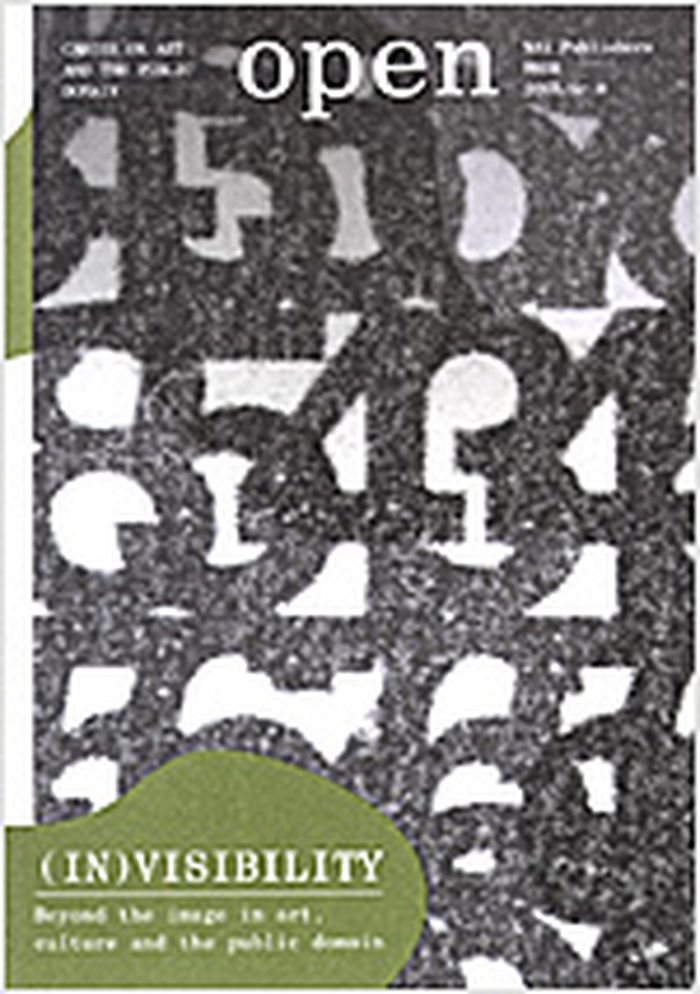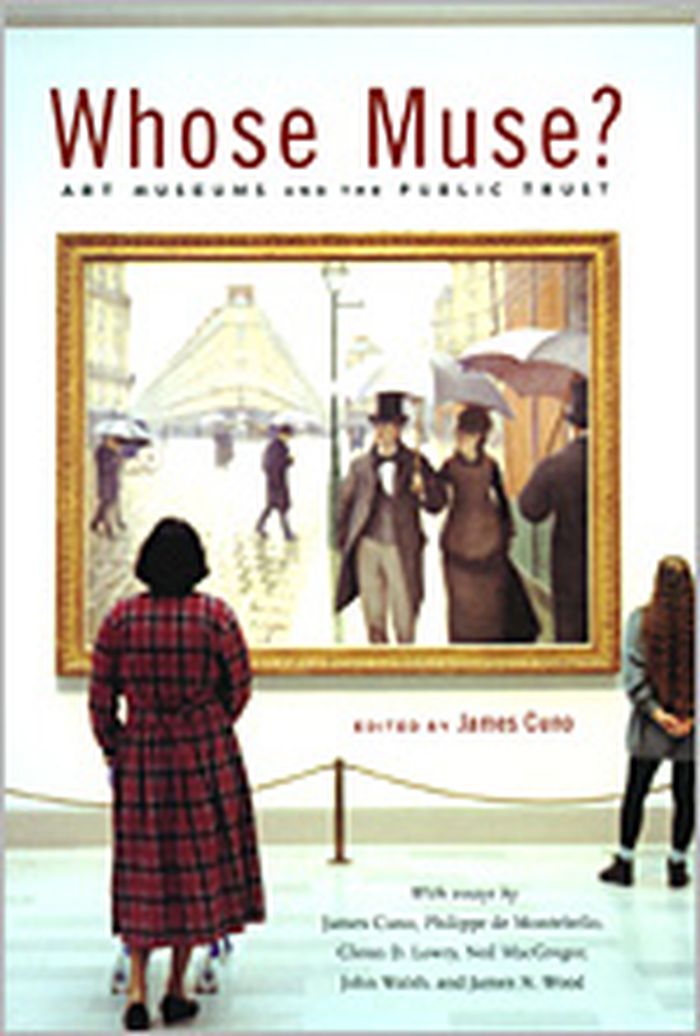$24.00
(available to order)
Summary:
TEXTE ZUR KUNST stands for controversial discussions and contributions by internationally leading writers on contemporary art and culture. Alongside ground-breaking essays the quarterly magazine, founded in Cologne in 1990 and published in Berlin since 2000, offers interviews, roundtable discussions and extensive reviews on art, film, music, market and fashion as well as(...)
Texte zur kunst 71: artists' artists, september 2008
Actions:
Price:
$24.00
(available to order)
Summary:
TEXTE ZUR KUNST stands for controversial discussions and contributions by internationally leading writers on contemporary art and culture. Alongside ground-breaking essays the quarterly magazine, founded in Cologne in 1990 and published in Berlin since 2000, offers interviews, roundtable discussions and extensive reviews on art, film, music, market and fashion as well as on art history, theory and cultural politics. Since 2006 the comprehensive main section section, each time devoted to a different topic, and selected reviews are published in both German and English. With every issue internationally renowned artists support the magazine with exclusive artists’ editions.
Magazines
$78.95
(available to order)
Summary:
Founded by Eyal Weizman at Goldsmiths College in London in 2010, the research agency Forensic Architecture has investigated dozens of incidents of state violence—military intervention, environmental destruction, border violence and police murder. Working at the intersection of architecture, law, journalism, human rights and ecology, Forensic Architecture researches(...)
Architecture Monographs
December 2022
Forensic architecture: Witnesses
Actions:
Price:
$78.95
(available to order)
Summary:
Founded by Eyal Weizman at Goldsmiths College in London in 2010, the research agency Forensic Architecture has investigated dozens of incidents of state violence—military intervention, environmental destruction, border violence and police murder. Working at the intersection of architecture, law, journalism, human rights and ecology, Forensic Architecture researches conflicts and crimes around the world, using architectural tools and methods to conduct spatial and architectural analyses of particular incidents. They do not design new buildings, but like other architects, they examine and model spaces, with the aim of shedding light on events. This catalog focuses on the witnesses at the core of Forensic Architecture’s work. Featuring texts by Weizman, Christina Varvia and a roundtable discussion between members of the current team, this richly illustrated book opens a window into Forensic Architecture’s working methods and projects.
Architecture Monographs
$17.95
(available to order)
Summary:
This book is based on a conference sponsored by the National Endowment for the Arts with the Woodrow Wilson Center concerning strategies for the reuse of dead malls in America's first-ring suburbs. Originally celebrated as community centers, the substantial commercial success of the early suburban shopping center was fleeting, as subsequent generations of ever-larger(...)
small format
September 2002, Washington, D.C.
Sprawl and public space : redressing the mall
Actions:
Price:
$17.95
(available to order)
Summary:
This book is based on a conference sponsored by the National Endowment for the Arts with the Woodrow Wilson Center concerning strategies for the reuse of dead malls in America's first-ring suburbs. Originally celebrated as community centers, the substantial commercial success of the early suburban shopping center was fleeting, as subsequent generations of ever-larger malls have left behind a landscape of struggling and boarded- up shells. This pervasive condition is presented in the context of the history of public space and the shopping mall. The book includes essays by Robert Fishman, Benjamin Barber and Margaret Crawford and innovative projects for the strip and mixed-use developments by such architects as RoTo, Lewis, Tsurumaki, Lewis, ShoP and Gary Handel + Associates. A roundtable with developers and bankers on obstacles to the redevelopment of failed shopping centers is also included. The review of case studies and projective work is intended to foster a more serious examination of new models for making and using public space.
small format
Salt and silver
$67.50
(available in store)
Summary:
Salt prints are the very first photographs on paper that still exist today. Made in the first twenty years of photography, they are the results of esoteric knowledge and skill. Individual, sometimes unpredictable, and ultimately magical, the chemical capacity to ‘fix a shadow’ on light sensitive paper, coated in silver salts, was believed to be a kind of alchemy, where(...)
Salt and silver
Actions:
Price:
$67.50
(available in store)
Summary:
Salt prints are the very first photographs on paper that still exist today. Made in the first twenty years of photography, they are the results of esoteric knowledge and skill. Individual, sometimes unpredictable, and ultimately magical, the chemical capacity to ‘fix a shadow’ on light sensitive paper, coated in silver salts, was believed to be a kind of alchemy, where nature drew its own picture. Salt and Silver brings together over 100 plates drawn from the Wilson Centre for Photography, accompanied by two roundtable discus- sions with curators, academics, historians and collectors from world renowned institutions. Encompassing many of the great works of the period, the publication includes prints by Edouard Baldus, Louis Blanquart-Evrard, Mathew Brady, Charles Clifford, Louis De Clercq, Maxime Du Camp, Roger Fenton, Jean-Baptiste Frenet, Charles Hugo, David Octavius Hill, Robert Adamson, Calvert Richard Jones, Gustave Le Gray, Henri Le Secq, Charles Marville, Felix Nadar, Charles Negre, Felice Beato, Auguste Salzmann, William Henry Fox Talbot, Felix Teynard and Linnaeus Tripe.
Photography Collections
$36.00
(available to order)
Summary:
In our culture, in which the media play a predominant role, there is an increasing emphasis on achieving visibility and transparency. Openness and communication are subservient to that visibility, and even seem to coincide with it more and more emphatically. At the same time, both notions form the foundations for social order and political power. In our over-visualized(...)
Open 8 : (in)visibility : beyond the image in art, culture and the public domain
Actions:
Price:
$36.00
(available to order)
Summary:
In our culture, in which the media play a predominant role, there is an increasing emphasis on achieving visibility and transparency. Openness and communication are subservient to that visibility, and even seem to coincide with it more and more emphatically. At the same time, both notions form the foundations for social order and political power. In our over-visualized culture, however, it seems as if every message or social agenda is being squeezed out in favour of styling, commerce and fashion. What position does art occupy in this, or what position should it occupy? In "Open" 8, guest editors Willem van Weelden and Jan van Grunsven write a general introduction, Brian Holmes explores (in)visibility as a tactic in art, and Jouke Kleerebezem asks who actually decides about (in)visibility in the public space; Camiel van Winkel writes over the visual deficit of contemporary culture; Dieter Lesage critically examines the proposals by OMA/AMO for a new iconography of Europe; Henk Oosterling investigates the FBI's prosecution of the Critical Art Ensemble; Jorinde Seijdel considers how media images are used as evidence for social and political events. "Open" 8 includes interviews with Arno van der Mark of DRFTWD, an Amsterdam-based multidisciplinary design bureau, and with the French research organization Bureau d'études, as well as an account of a roundtable discussion about a possible new legitimation for academic training in 'art and the public space'. The cahier also presents a column by the Belgian architect/author Wouter Davidts, photographic essays and book reviews.
Magazines
$41.95
(available to order)
Summary:
During the economic boom of the 1990's, art museums expanded dramatically in size, scope, and ambition. They came to be seen as new civic centers : on the one hand as places of entertainment, leisure, and commerce, on the other as socially therapeutic institutions. But museums were also criticized for everything from elitism to looting or illegally exporting works from(...)
Museums and Universal Exhibitions
January 2004, Princeton / Cambridge, Mass.
Whose muse? : art museums and the public trust
Actions:
Price:
$41.95
(available to order)
Summary:
During the economic boom of the 1990's, art museums expanded dramatically in size, scope, and ambition. They came to be seen as new civic centers : on the one hand as places of entertainment, leisure, and commerce, on the other as socially therapeutic institutions. But museums were also criticized for everything from elitism to looting or illegally exporting works from other countries, to exhibiting works offensive to the public taste. "Whose Muse?" brings together five directors of leading American and British art museums who together offer a forward-looking alternative to such prevailing views. While their approaches differ, certain themes recur : as museums have become increasingly complex and costly to manage, and as government support has waned, the temptation is great to follow policies driven not by a mission but by the market. However, the directors concur that public trust can be upheld only if museums continue to see their core mission as building collections that reflect a nation's artistic legacy and providing informed and unfettered access to them. The book, based on a lecture series of the same title held in 2000-2001 by the Harvard Program for Art Museum Directors, also includes an introduction by Cuno and a fascinating - and surprisingly frank - roundtable discussion among the participating directors. A rare collection of sustained reflections by prominent museum directors on the current state of affairs in their profession, this book is without equal. It will be read widely not only by museum professionals, trustees, critics, and scholars, but also by the art-loving public itself.
Museums and Universal Exhibitions
